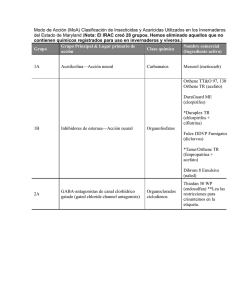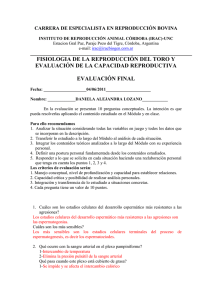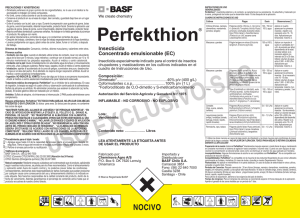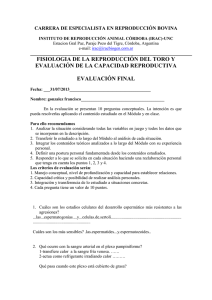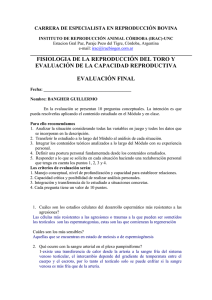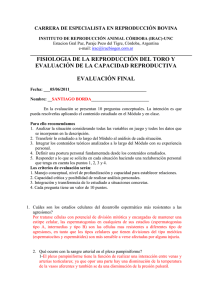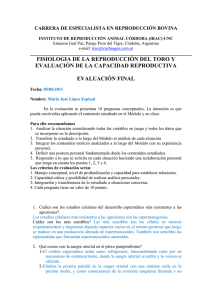Sucking Pest WG
Anuncio
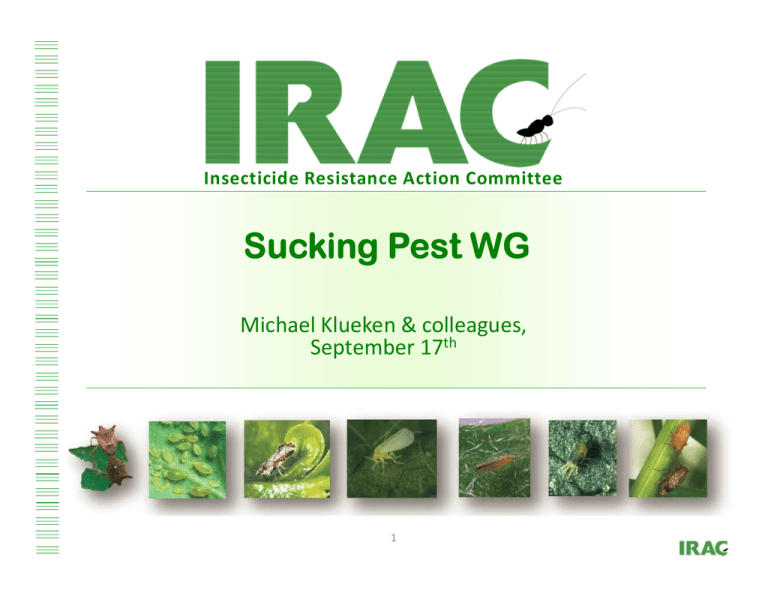
Insecticide Resistance Action Committee Sucking Pest WG Michael Klueken & colleagues, September 17th 1 content - Antitrust reminder Feedback “Resistance 2015” Team structure M. persicae B. tabaci – PROMIP-results E. heros – PROMIP-results Diaphorina citri Potato psyllids A. gossypii – Korea Cereal aphids Europe Olive fly – diptera – PYR resistance A.o.b. 19 October, 2015 Anti-trust Reminder • All IRAC meetings are held under anti-trust rules and regulations. • Regulations are developed under guidence from Croplife International • All discussions should be technical discussions and NOT commerical. • Do not talk about individual products (active ingredient or mode of action only) • Do not talk about prices, marketing strategies,etc. • If you have any concerns – please stop the conversation and consult with IRAC Brazil or IRAC International colleagues. • A copy of the anti-trust guidelines can be provided to those requiring a copy. Antitrust Law Reminder for all CropLife International meetings “IRAC Committees and IRAC Members should be aware that while some activities among competitors are both legal and beneficial to the industry, group activities of competitors are inherently suspect under the antitrust laws. Agreements or combinations between or among competitors need not be formal to raise questions under antitrust laws, but may include any kind of understanding, formal or informal, secretive or public, under which each of the participants can reasonably expect that another will follow a particular course of action. All IRAC Members have a responsibility to see that topics, which may give an appearance of an agreement that would violate the antitrust laws, are not discussed during meetings, conference calls or in any other forum. It is the responsibility of each member in the first instance to avoid raising improper subjects for discussion and the purpose of the Antitrust Guidelines is to assure that participants are aware of this obligation” …. 19 October, 2015 IRAC-Sucking Pest WG Team structure – 2015 • BASF representative: Lixin Mao (BASF-internal discussion) Team structure as of September, 2015: 19 October, 2015 5 IRAC-Sucking Pest WG Objectives – 2015 Goals Short term actions to minimise spread of resistant pests Prepare IRM guidelines for pests with, or at risk of developing resistance in the mid term Objectives • Myzus persicae Follow-up with “implementation” of IRM Guidelines in Southern EU • Bemisia tabaci monitoring program (PROMIP) • Sitobium avenae review last year’s alert for Mainland EU for PYR-resistance (in view of few MOAs) • Aphis gossypii (neonicotinoid target site resistance) Initiate local IRAC team in South Korea Develop IRM recommendations for Korea as template for future use Finalize / review poster: globally & local Korean language version • • • • • Euschistus heros, in Brazil (e.g. IRAC01, 03, 04) Follow up with monitoring efforts in Brazil e.g. PROMIP/IRAC-BR, Method validating and implementation (review vial test to IRAC approved methods) Bathycoelia distincta Support research efforts in RSA (suspected PYR-resistance) Diaphorina citri Finalize and publish the Leaf Dip method for IRAC Groups 01, 03, 04, 05, 06 Validate and publish a Flush tube systemic test for IRAC Groups 23 and 28 Bemisia tabaci (T. vaporariorum) updated poster version incl. new MOA guidelines Group 4 IRM Guidelines. Review and finalize – update global document in view of new subgroupings Lygus sp USA Cotton engage with IRAC US to assess need for action Timeline 2015 Q2 2015 Q3 2015 Q2 2015 Q2 2015 2015 Q2 2015 Q3 2015 2015 Q2 2015 Q4 2015 2015 Q1 2015 2015 • fruit fly species (pyrethroids-resistant olive fly suspected, Greece): 1. Summarize current resistance situations for diptera, 2. Exchange about methodology, 3. Pro-actively release IRAC recommendations, highlight value of current options / prevent use restrictions Prepare for future Sucking Pest problems long term (avoiding resistance development) 19 October 2015 Tetranychus sp. (mites), Diaphorina citri , Nilapavarta lugens, Dichelops melacanthus (stinkbugs) Collect reports on monitoring studies and publications, follow up field failures Aphis gossypii (neonicotinoid target site resistance) Monitor complaints globally and report liaise with researchers 6 2015 2015 M. persicae – new data 2015 Steve has circulated an example, incl. methods, that can be used to inform local company representatives in Southern-Europe (esp. in ITA, ESP and FRA). We believe it is important to follow-up M. persicae populations not only on their winter host (stone fruits), but also on summer hosts or other secondary hosts. This can include vegetables, tobacco, and broad acre crops (e.g. oil seed rape, sugar beet, potato). It is not too late for 2015, because populations in summer and autumn might be exposed to further IRAC Gr. 4 a.i.’s potentially selecting further for resistance. Did everyone send reminder mail to local company representative? Did Syngenta (or Bayer) received samples? Any suggestion, when new results be available? 19 October, 2015 7 M. Persicae – new poster version 2015 19 October, 2015 8 Principales mecanismos de resistencia a insecticidas en el pulgón verde del melocotonero, Myzus persicae E S P A Ñ www.irac-online.org Comité de Acción contra la Resistencia a Insecticidas A (Sulzer) . Introducción y datos biológicos El pulgón verde del melocotonero, Myzus persicae (Sulzer) es una plaga polífaga y cosmopolita. Su hospedador primario es Prunus persicae (incluyendo nectarinas), mientras que los secundarios incluyen plantas de 40 familias diferentes, entre las cuales se encuentran cultivos económicamente importantes. Además de los daños directos, M. persicae es un vector muy eficiente de más de 100 virus distintos de plantas. Los primeros casos de resistencia a insecticidas en M. persicae datan de 1955. Hasta la fecha se han detectado cinco mecanismos de resistencia, los cuales presentamos brevemente en este póster. Estos mecanismos confieren resistencia de M. persicae a carbamatos, organofosforados (OFs), piretroides y neonicotinoides. No se conocen casos de resistencia verificados en campo al resto de los grupos de MdA. El uso combinado de técnicas de detección de resistencias en las poblaciones de campo proporciona información sobre posibles problemas con algunos insecticidas y una ayuda para mejorar las estrategias de control. .1. Nivel elevado de esterasas • Tipo de Resistencia: Metabólica. • Afecta a: Carbamatos, OFs y en menor grado a piretroides. • Las esterasas son enzimas solubles que hidrolizan enlaces éster. • La sobreproducción de carboxilesterasas (E4 y EF4) por parte M. persicae genera resistencia a estos insecticidas, cuyos enlaces éster son capturados o degradados antes de alcanzar su sitio de acción. 2. Nivel elevado de la monooxigenasa citocromo-P450 • Tipo de Resistencia: Metabólica. • Afecta a:. • Qué son… • Qué provocan… 3. Modificación de la acetilcolinesterasa (AChE de sus siglas en •inglés) Tipo de resistencia: Sitio de acción. • Afecta a: Carbamatos y Organofosforados (OFs). • En condiciones normales la AChE degrada la acetilcolina para . Directrices de prevención de resistencia • Se recomienda alternar compuestos de diferente modo de acción. el buen funcionamiento del sistema nervioso de M. persicae. • Los Carbamatos y OFs inhiben el funcionamiento de la AChE, lo que provoca la sobreestimulación y sobreexcitación del pulgón. • La modificación de la estructura de la AChE, por sustitución de una serina en posición 431 por una fenilalanina, provoca que su acción no sea inhibida por estos insecticidas, por lo que el Sistema nervioso del pulgón puede funcionar perfectamente. 4. Modificación del Receptor nicotínico de la AcetilColina (nAChR de sus siglas en •inglés) Tipo de resistencia: Sitio de acción. • Afecta a: Neonicotinoides (NNI). • En condiciones normales el nAChR fija a la acetilcolina para el buen funcionamiento del sistema nervioso de M. persicae. • Los NNI se fijan al nAChR en lugar de la acetilcolina, lo que no permite el normal funcionamiento de la transmisión nerviosa. • La modificación de la estructura del nAChR (por mutación R81T en la subunidad ß1 del bucle D de M. persicae), provoca que éste ya no reconoce al insecticida que se fijaba a él, por lo que el sistema nervioso del pulgón puede funcionar perfectamente. (no repetir aplicaciones consecutivas). • Se recomienda no utilizar un mismo modo de acción más de una vez por ciclo de cultivo. • Si se observa un descenso significativo de los niveles de control de M. persicae, se recomienda dejar de emplear los insecticidas de este modo de acción. • En las aplicaciones pre-florales en frutales, se recomienda la utilización de aceite solo o en mezcla con aficidas**. • Emplear sólo productos autorizados, siguiendo las instrucciones de etiqueta. Ver poster tuta / medidas alternativas * Observar limitaciones abejas (ver etiqueta) M. persicae puede ser resistente a estos insecticidas en algunas zonas. Consultar con los técnicos locales **Confirmar la disponibilidad de registro . Modos de Acción (MdA) autorizados en España contra M. persicae (Julio 5. kdr o super kdr (resistencia “knock-down”) 2015) Grupo principal/ Punto de acción primario • Tipo de resistencia: Sitio de acción. • Afecta a: Piretroides. • En condiciones normales los canales 1 Inhibidores de la acetilcolinesterasa. de sodio dependientes del voltaje regulan la entrada y salida de iones Na+ de los axones, proceso necesario en la transmisión nerviosa del pulgón. • Los piretroides bloquean estos canales de sodio, provocando….. • Los cambios en la proteína del canal de sodio dependiente del voltaje (la sustitución de leucina por fenilalanina da lugar a genotipos kdr) provocan… • Los individuos con resistencia kdr por lo general también muestran altos niveles de esterasa E4 (que contribuye a la resistencia a piretroides). . 3 Moduladores del canal de sodio. 4 Agonistas del receptor nicotínico de la acetilcolina (nAChR) 9 Moduladores de los órganos cordotonales 23 Inhibidores de la acetil CoA carboxilasa UN Compuestos de modo de acción desconocido o incierto Subgrupo químico o materia activa representativa 1A Carbamatos. 1B Organofosforados. 3A Piretroides / Piretrinas. 4A Neonicotinoides. (4D Flupiradifurona). 9B Pimetrozina. 9C Flonicamid. Derivados de los ácidos tetrónico y tetrámico Azadiractín Referencias 1. 2. Jeschke P & Nauen R (2008) Neonicotinoids: From zero to hero in insecticide chemistry. Pest Manag Sci 64, 1084 Devonshire AL (1998) The evolution of insecticide resistance in the peach-potato aphid, Myzus persicae. Phil. Trans. R. Soc. Lond. B 353, 1677. Este póster tiene fines meramente educativos. A nuestro entender la información detallada es correcta pero IRAC y sus empresas asociadas no se hacen responsables del uso o interpretación que se haga de ella. Siempre se debe consultar a Servicios oficiales o técnicos locales y seguir las recomendaciones de las etiquetas. (Sustancias en gris entre paréntesis): Aquellas presentadas para su registro en España pero todavía sin autorización de uso concedida. Documento IRAC protegido por © Copyright Basado en póster diseñado por IRAC Sucking Pest WG Para más información visite la web de IRAC: www.irac-online.org Research March 2014, Poster Ver. 9 Fotografías cortesía de USDA y Rothamsted B. tabaci: action: new poster version, covering all MOAs The most recent poster is October 2008. The new version should cover - all MOAs and may - possibly incorporate Trialeurodes vaporarium as well as Bemisia tabaci? 19 October, 2015 10 IRM recommendation for HLB-vector control ACP: action: add IRAC gr. 4D Flupyradiflurone 19 October, 2015 11 IRM recommendation for HLB-vector control ACP: action: comparison of methods Leaf-dip method (expect for IRAC group 23) • is on the web page • Validated by BASF (BRA) for Imidacloprid and Thiametoxam (2014) • but no new data expected to come Flush tube systemic method (e.g. for IRAC Groups 23 and 28) • Method description by Juan • a few changes by Steve (&colleagues) and by Lixin • not yet final - by when to publish? Further validation / comparison is needed: • incl. other MOAs – which? • who can do by when? 19 October, 2015 12 tomato-potato psyllid, Bactericera cockerelli: action: draft method for contact/systemic MOA? Juan mentioned that we need to find a method for the tomato-potato psyllid, Bactericera cockerelli. 19 October, 2015 13 Arising sucking pest resistance problems: Aphis gossypii • • • • • • • Korea – NNI failure reports and problem is apparently spreading nationwide: Korea publication equivocal. Sampling in 2013 by Bayer, results nya. Japan – No new reports since 2012. (Miazaki, Southern Kyushu, 3 Aphis gossypii populations from Cucumber and Pepper with signifcant loss of control to 5 neonicotinoids but less to ACETAMIPRID and THIACLOPRID Dr Matsuura, July 2012.) China – R81T subsititution (like in Myzus) produced in the lab after 60 generations exposure to IMIDACLOPRID in Aphis gossypii Spain – some isolated reports, but nothing confirmed Brazil – no issues reported, so not on IRAC BR priority list. Mainly use ACETAMIPRID + CARBOSULFAN also in mixtures amogst others USA – isolated reports from Jeff Gore but no detection of resistance – 8X NNI shift in LA, MS, AR Australia - Grant Heron – Aphis gossypii resistance to NNIs has not increased in 2011/2012 season. R-factors below typical R81T levels, no evidence of mutation Other reports from countries/companies?? 14 Action for 2014 – Monitor NNI performance in all countries. Continue to use bioassays. 15 Aphis gossypii, Korea: action: reviving & extending the local activities Next steps: Focus on a most critical crop to develop IRM recommendations (cucurbits/peppers) and ask them directly for the information that is needed, e.g.: Annual cropping cycle information (duration of crop from seedling transplant to harvest/crop removal), parallel or sequential planting. Aphis pest timings (when aphids are normally present in the crop) and of other pest timings. Available pest control options based on modes of action & any restrictions based on those. Biological & cultural control methods. With this information, we may produce an IRM draft ourselves and then ask the Korean colleagues to challenge it. Subsequently, a 2-step approach for further meetings is probably recommendable: 1st smaller group tel con (agrochemical companies), 2nd adding large distributors and research institutes (probably in Korean language) 19 October, 2015 16 Aphis gossypii, Korea: action: suggest a spray prg. / window approach… 17 Aphis gossypii, Korea: action: challenge local team for completeness of spray prg. 5 1B 21A 4, 23 (foliar) 4A ST/ drench 15 6, 21A Spider mites: Tetranychus spp Whitefly: B tabaci A. gossypii Thrips Rust mites Lepidoptera: Spodoptera/Helicoverpa Leaf miner pollinators? seed transplanting nursery Feb. flowering 10 0 April 20 Mai A. swirskii first fruits 30 June 18 ripe fruits / harvesting……....... 40 July 50 August 60 Sept. DAT PYR-resistance Sitobium avenae in UK country information spread to region 19 Olive Fruit Fly: action: set up a core team Generally, SP WG participants showed interest to cover and work on specific dipteran topics in our meetings on an ad-hoc basis. - Should other individuals e.g. of Lep.-WG be included as well? Next steps might follow, e.g.: 1. Summarize current resistance situations vs. PYR 2. Exchange about methodology 3. Pro-actively release IRAC recommendations, highlight value of current options / prevent use restrictions. 19 October, 2015 20 Stinkbug – PYR resistance in South Africa: action: finalize contract Research efforts for two-spotted stinkbug Bathycoelia distincta in macadamia (suspected PYR-resistance) are funded by IRAC in 2015: Discussions are going on about the actual project definition and design of the contract with IRAC. • The research is performed by Gerhard Nortje • Jan Van Vuuren is the contact partner for IRAC-SP WG. 19 October, 2015 21 IRAC INDIA: action: kick-off for sucking pests topics? IRAC INDIA (Nigel Godel, Lepidopteran Working Woup): - they are resuming activity - on September 10th: hold a face to face at the Bayer office in Mumbai - Nigel provided already: - Latest revised Guideline decided by IRAC Global for the countries - Latest update on global activities which can be shared with group. - Guidance us on the objectives and expectation of global IRAC team from India - Nigel will send further material next months, incl. 2014 Lep. group summary, which contains the overview of activities, 2015-16 smart objectives and challenges Is there any other specific guidance from Sucking Pest working group and encouragement we can provide to the new IRAC India team? 19 October, 2015 22 19 October, 2015 23
